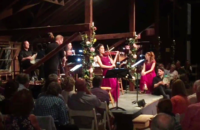by Alice Koeninger

The concert featured cellist René Schiffer, double bassist Dave Morgan, fiddler Emi Tanabe, and percussionist Rex Benincasa, along with Mor (recorder and ney), Sorrell (lautenwerk — a gut-strung harpsichord), and Tina Bergmann (hammered dulcimer). Organized in seven sections (Our Journey Begins, Encounters on Distant Shores, Lovers’ Laments, Wandering the Riviera, Sephardic Women, Wedding Dances, and Love Beyond Boundaries), the program denoted the different regions of the Mediterranean where the music originated, beginning in the Middle East and ending in Spain.
The adventure was centered around a work by Sufi poet Rumi, titled Where Everything is Music. Powell recited the poem in three parts, weaving its text between songs to emphasize the program’s underlying theme: that we are better when we come together through music.
Although a tarantella wasn’t played until after intermission, the energetic spirit of that dance was present throughout the performance. The players showed genuine enthusiasm as they stomped, clapped, and sang along to the music. Kay and Powell delivered some beautiful duets, his tenor harmonies creating an intriguing layer with her soprano melody. Mon amy s’en est allé (1615) during “Lover’s Laments” showcased Kay’s sweet voice and Powell’s strong acting as a scorned lover dancing around him.
Tsamiko Dance — Galani Galaziani, a traditional Greek dance arranged by Bergmann, featured her in a dulcimer solo, the silver hammers flashing as she struck every note like she was casting a spell. Sorrell described the lautenwerk and Bach’s affection for it before launching into the 15th-century Lamento di Tristano. After intermission, Kay performed Pierre Attaingnant’s 16th-century lute solo Branles, his brow creased in concentration as his fingers flew across the fingerboard.
The traditional Sephardic songs Y una Madre/Tres Hermanikas were brought to life by Powell’s and Tanabe’s electrifying solos. Powell brought together her rich voice and her dramatic storytelling in Tres Hermanikas, and Tanabe wriggled her body along with her bow as she painted a picture of the third sister’s exploits.
Before her recorder solo during a Greek wedding song, Mor told the audience about her childhood in Israel and her special affection for the Sephardic side of her family. She quipped, “Are you ready to throw the plates?” before the ensemble picked up the lively dance melody, propelled by Mor’s high-pitched and intricate playing. Other songs showed off the talents of Schiffer, Morgan, and Benincasa, each taking their turn to solo like in a jazz ensemble.
The trip around the Mediterranean featured many different types of songs in multiple languages, from Italian to Arabic to French to Sephardic, all expressed with energy and skill. Powell was especially theatrical in her role as lead vocalist and narrator, often stretching out her arms as she sang or told a story to engage the audience further.
Many pieces — such as Pizzica di San Vinto, a traditional Italian tarantella and the last song on the program — began with one part, often just the rhythm, then continued with the layering of other instruments. This dynamic and intoxicating effect mounted in vigor, ending with a victorious stomp or shout as each ensemble member lifted an arm into the air in triumph. The spirit of the music and stories was infectious, and as Rumi wrote, helped the audience “open the window” in their chests “and let the spirits fly in and out.”
Published on ClevelandClassical.com June 12, 2018.
Click here for a printable copy of this article



